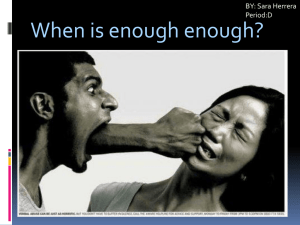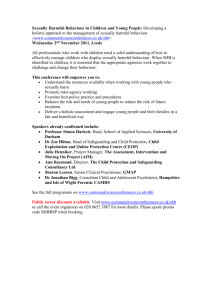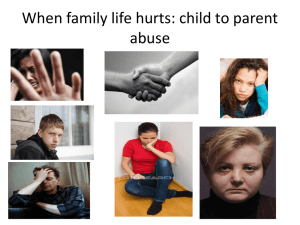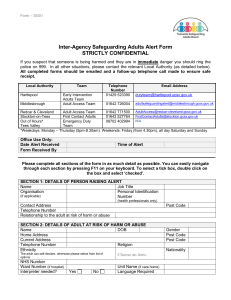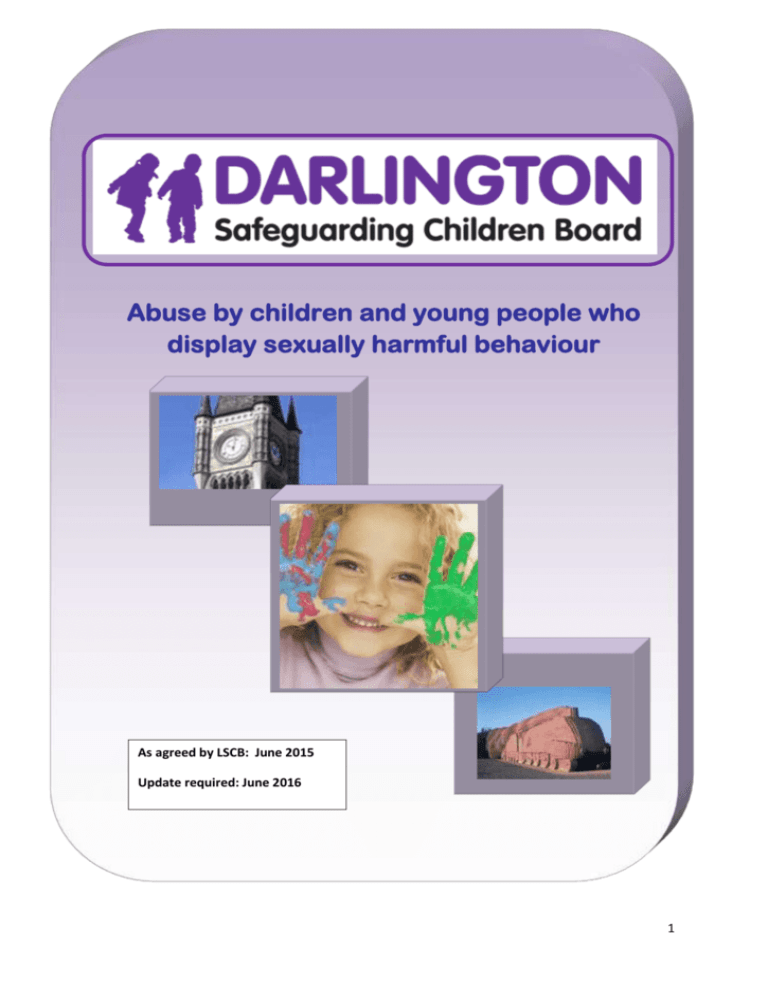
Abuse by children and young people who
display sexually harmful behaviour
As agreed by LSCB: June 2015
Update required: June 2016
1
Abuse by Children and Young People who Display Sexually Harmful
Behaviours
Introduction
Children, particularly those who are living away from home, can be vulnerable to physical,
sexual and emotional bullying and abuse by their peers. Such abuse should always be taken
as seriously as abuse perpetrated by an adult, and the same safeguarding children
procedures apply.
A significant proportion of sex offences against children are committed by
peers. Professionals working with children and young people need clear guidance and
training to enable them to identify sexually harmful behaviours. Professionals should not
dismiss some abusive sexual behaviour as “normal” between young people and should not
develop high thresholds before taking action.
Children and young people who abuse others should be held responsible for their abusive
behaviour, while being identified and responded to in a way that meets their needs as well
as protecting others.
Key Principles
The following key principles should underpin all work with children who abuse others:
Incidents of sexually harmful behaviour should be dealt with under Child Protection
procedures which recognise the Child Protection and potentially criminal element to
the behaviour. There should be a coordinated response between the agencies within
Darlington Safeguarding Children Board;
The needs of the children and young people who abuse others should be considered
separately from the needs of their victims;
An assessment should be carried out in each case of abuse, appreciating that
children who abuse others may have unmet developmental needs and may have
suffered considerable disruption in their lives, been exposed to violence within the
family, may have witnessed or been subject to Physical Abuse or Sexual Abuse,
have problems in their educational development and may have committed other
offences. Such children are likely to be Children in Need; some will have suffered
Significant Harm and may be in need of protection themselves. Children who abuse
others should be held responsible for their abusive behaviour while being identified
and responded to in a way which meets their needs as well as protecting others;
Early and effective, intervention with children and young people who abuse others
may play an important part in protecting children, by preventing the continuation or
escalation of abusive behaviour.
Sexual Abuse
Harmful sexual behaviour involves one or more children engaging in sexual discussions or
acts that are inappropriate for their age or stage of development. These can range from
using sexually explicit words and phrases to full penetrative sex with other children or adults.
Sexual abuse perpetrated by children can be just as harmful as that perpetrated by an adult,
so it is important to remember the impact on the victim of the abuse, as well as to focus on
the treatment of the child or young person exhibiting the sexually harmful behaviour.
2
Sexual behaviour between children is considered harmful if it involves coercion or threats of
violence or one of the children is much older than the other, or there is the presence of
another power imbalance (for example because one child has a disability affecting their
ability to consent).
The sexual development of all children and young people takes place along a continuum
and the boundaries between what is abusive and what is part of normal childhood or youthful
experimentation can be blurred. Professionals will need to determine whether a child’s
sexual behaviour is part of healthy sexual development or harmful. Factors to consider
include; consent, power imbalance and exploitation. If a child uses sexual actions or
language they should not be familiar with, it is important to address this behaviour
immediately.
Where children exhibit a range of sexually problematic behaviour such as indecent
exposure, obscene telephone calls, fetishism, bestiality, sexual abuse against adults or
children and downloading indecent images of children from the internet a referral to
Children’s Social Care should always be made.
Referral
Anyone who has a concern that a child might have been abused by another child should
refer their concerns to Children’s Social Care Services in accordance with the Referrals
Procedure. Allegations of peer abuse will be taken as seriously as allegations of abuse
perpetrated by an adult. Children’s Social Care Services will discuss the concerns with the
referrer, decide whether to commence an Assessment and whether it is necessary to hold a
Strategy Discussion and Section 47 Enquiry.
Separate enquiries and investigations will be pursued in respect of the victim and the alleged
abuser.
Where relevant, Assessments will be undertaken in relation to the alleged abuser in
conjunction with the Youth Offending Team (YOT).
Consideration should be given to the need for a different social worker to be allocated to the
victim and to the child with the alleged abusive behaviour, even if they live in the same
household, to ensure that both are supported through the process of the enquiry and that, in
relation to both children, their needs are fully assessed.
It should be recognised that disclosure of sexually inappropriate behaviour or abusive
behaviour by a child can be extremely distressing for parents and carers. The child and their
family should always be advised of their right to seek legal advice and be supported through
the process.
The Police will always consult with Children’s Social Care Services regarding cases that
come to their notice in order to ensure that there is an assessment of the victim’s needs and
that in all cases, there is an assessment of the alleged abusing child’s needs. Each child
should be referred to the Children’s Social Care Services Team responsible for their home
address.
Children with sexually abusive behaviour who are returning to the community following a
custodial sentence or time in secure accommodation also require consideration throughout
this procedure.
3
Strategy Discussion
Children’s Social Care Services and the Police will convene a Strategy Discussion (usually a
meeting) in relation to the alleged abusing child and the child victim where there is
reasonable cause to suspect that the child concerned is suffering or likely to suffer
Significant Harm, for example because of concerns about the parents’ ability to protect the
child victim from further abuse.
Where Strategy Discussions are required for both the child who is the alleged abuser and
the child who is the victim, these should be held separately.
Care must be taken to ensure that the appropriate professionals attend the right meeting in
order to provide confidentiality for the children involved. For example, school representatives
should only attend the meeting involving the pupil at their school. The police officer and
social workers who are conducting the enquiries should participate in both sets of Strategy
Discussions.
Where a Strategy Discussion relates to an alleged abusing child who is over the age of 10, a
representative from the Youth Offending Team must attend.
The Strategy Discussions must plan in detail the respective roles of those involved in the
enquiries and ensure that the following objectives are met:
Information relevant to the protection and needs of the alleged victim is gathered;
Any criminal aspects of the alleged abuse are investigated;
Any information relevant to any abusive experiences and protection needs of the
child who is the alleged abuser, is gathered;
Any information about the risks to self and others, including other children in the
household, extended family, school, peer group or wider social network, is gathered.
Where there is suspicion that the child who is the alleged abuser is also a victim of abuse,
the Strategy Discussion must decide the order in which interviews with the child will take
place.
When a child is aged 10 or over and is alleged to have committed an offence, the first
interview must be undertaken by the Police under the provisions of the Police and Criminal
Evidence Act 1984.
In complex situations where there are a number of victims and possible perpetrators, the
Strategy Discussion should appoint a Strategic Management Group to co-ordinate the
overall investigation. (See Complex (Organised or Multiple) Abuse Procedure).
Assessment and Section 47 Enquiries
If, from information gathered during the Assessment, it appears that either the perpetrator
child or the victim child is suffering or likely to suffer Significant Harm, the Section 47 Enquiry
process will be followed.
In these circumstances, relevant considerations include:
The nature and extent of the abusive behaviours and the impact on the victim;
4
The context of the abusive behaviours;
The age of the children involved;
The child’s development, and family and social circumstances;
Whether the perpetrator child acknowledges the alleged behaviour;
Whether there are grounds to suspect that the perpetrator child has been abused or
that adults have been involved in the development of the sexually harmful behaviour;
Both children’s needs for services; and
The risks the perpetrator child poses to him/herself and others, including other
children in the household, extended family, school, peer group or wider social
network.
This risk is likely to be present unless: the opportunity to further abuse is ended, the child
has acknowledged the abusive behaviour and accepted responsibility and there is
agreement by the child and his/her family to work with relevant agencies to address the
problem.
If during the course of the Assessment there are concerns about any risks to other children
posed by the perpetrator child, a multi-agency meeting should be convened straight away to
develop:
A written risk management plan in relation to any child identified as at potential risk;
including educational and accommodation arrangements both for the perpetrator
child and the potential victim/s;
Appropriate arrangement for the continuation of the assessment and the need for any
specialist assessment; and
How the services to be provided will be coordinated.
The meeting should identify the Lead Professional and review process with clear timescales.
Outcomes of Assessment/ Section 47 Enquiries- Child (Perpetrator)
If the information gathered in the course of the Section 47 Enquiry suggests that the child
who is suspected or alleged to have sexually abused is also a victim, or potential victim, of
abuse including neglect, a Child Protection Conference must be convened. A representative
from the YOT team should be invited to the Initial Child Protection Conference.
If the child becomes the subject of a Child Protection Plan, the coordination of services will
continue through the Core Group, which should address the child’s inappropriate behaviour,
the potential risks the child poses to others as well as the concerns which resulted in the
need for a Child Protection Plan.
Where the Child Protection Conference concludes that the child who is suspected or alleged
to have sexually abused does not require a Child Protection Plan, consideration should be
given to the need for services to address any sexually abusive behaviour and the interagency responsibility to manage any risks. In these circumstances, a multi-agency meeting
must be convened by Children’s Social Care Services.
This should take place as early as possible after the Conference and should involve the
Children’s Social Care Services team manager as chair, the social worker, the referring
agency, the school (including sibling’s schools), health agencies as appropriate, the social
5
worker co-ordinating work with the victim, the parent/carers and the child (subject to age and
level of understanding).
The multi-agency meeting will develop the overall plan for the child including:
A written risk management plan in relation to any child identified as at potential risk;
including educational and accommodation arrangements;
Any future assessment, if required; and
How the services to be provided will be coordinated.
The meeting should identify the Lead Professional and review process with clear timescales.
Where the Strategy Discussion concludes there are no grounds for a Child Protection
Conference, but concerns remain regarding the child’s sexually problematic behaviour, s/he
will be considered as a Child in Need. In such cases, a multi-agency meeting should be
convened to consider the risk management as outlined above.
The decision to end the involvement of any specialist services should be made on a multiagency basis. Factors to consider in reaching this decision include:
The level of risk posed by the child to him or herself and others;
If the intended outcomes of the intervention have been achieved;
The capacity of the parents or care givers to respond appropriately to the child’s
needs;
The need for provision of ongoing support to the child/family.
Outcomes of Assessment/ Section 47 Enquiries- Child (Victim)
Where a Section 47 Enquiry in relation to a victim child concludes that the child is suffering
or likely to suffer Significant Harm, an Initial Child Protection Conference must be convened
to assess the risks and consider the need to safeguard the child through a Child Protection
Plan.
In all cases, the child/ren may require services to support them through interviews in line
with Achieving Best Evidence Guidance and through any court actions that may follow. The
assessments undertaken may determine that there is a need for support services, such as
counselling services whether the child is in need of safeguarding or a child in need. The
child’s social worker should keep up to date with developments by communicating with the
social worker for the alleged abusing child to ensure that the child victim remains
safeguarded.
Criminal Proceedings
When the alleged abusing child is over 10, the police will consult other agencies including
the Crown Prosecution Service to decide the most appropriate course of action within the
criminal justice system.
In cases where criminal proceedings are taken against an alleged abusing child, the YOS
should be added to the list of possible attendees at any meetings. Both the compilation of
the YOS “ASSET” Profile and the preparation of an Assessment will be facilitated through
this.
6
When a case is going through the Youth Court or the Crown Court, the YOS will provide
information for the Assessment process. This may include plea, bail conditions and
variations between adjournments.
7




